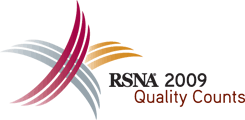
Abstract Archives of the RSNA, 2009
Seung A Choi MD, Presenter: Nothing to Disclose
Seung Soo Lee MD, Abstract Co-Author: Nothing to Disclose
Jung In-Hye, Abstract Co-Author: Nothing to Disclose
Han A Kim, Abstract Co-Author: Nothing to Disclose
Jae Ho Byun MD, Abstract Co-Author: Nothing to Disclose
Moon-Gyu Lee MD, Abstract Co-Author: Nothing to Disclose
The purpose of our study was to evaluate the effect of Gd-EOB-DTPA on respiratory-triggered T2-weighted turbo spin-echo (TSE) and diffusion weighted images (DWI) of focal hepatic lesions.
Sixty three consecutive patients having 173 focal hepatic lesions (117 malignant lesions, 27 cysts, 25 hemangiomas, and three abscesses) underwent respiratory triggered T2-weighted TSE and DWI (b=0,50,300,600,900) before and after Gd-EOB-DTPA enhancement (between 3-min and 20-min delayed T1-weighted imaging). Two blinded readers independently reviewed images to identify and characterize focal hepatic lesions (i.e. 1, cyst/ hemangioma; 2, equivocal; 3, solid lesion). The accuracy in detecting focal lesions was compared using free-response receiver operating characteristic analysis between non-enhanced and enhanced images. Agreement in lesion characterization was analyzed using the weighted kappa analysis. For hepatic lesions≥1cm, lesion to liver contrast-to-noise ratio (CNR) and apparent diffusion coefficient (ADC) were compared using the generalized estimating equations between non-enhanced and enhanced images.
For both TSE and DWI, the accuracies in detecting focal lesions were not significantly different between enhanced and non-enhanced images for both readers (P≥.614). There were good agreements in lesion characterization between enhanced and non-enhanced images for both readers (kw=.92 and .81 for TSE; .76 and .79 for DWI). Lesion to liver CNR was significantly higher on enhanced images than on non-enhanced images for DWI (98.6±98.3 vs. 87.8±85.0, P=.022), but the difference was not significant for TSE (P=.62). Mean ADC values of focal lesions were not significantly different between enhanced and non-enhanced DWIs (P=.75).
Gd-EOB-DTPA enhancement improves lesion to liver CNR of focal lesions on DWI and has no significant effect on the detection and characterization of focal lesions on T2-weighted TSE and DWI.
Acquisition of T2-weighted TSE and DWI between 3-min and 20-min delayed T1-weighted imaging can save scan time for Gd-EOB-DTPA enhanced liver MRI without any adverse effect on diagnostic accuracy.
Choi, S,
Lee, S,
In-Hye, J,
Kim, H,
Byun, J,
Lee, M,
Effect of Gd-EOB-DTPA Enhancement on Respiratory-triggered T2-weighted Imaging and Diffusion-weighted Imaging of the Liver. Radiological Society of North America 2009 Scientific Assembly and Annual Meeting, November 29 - December 4, 2009 ,Chicago IL.
http://archive.rsna.org/2009/8006659.html

